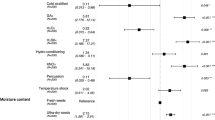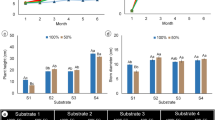Abstract
IN our preliminary report1 on vernalization of mustard (Brassica juncea, Hooker Type 27) it was shown that even seeds previously soaked which remain unsplit during the period of chilling are vernalized. Though the degree of vernalization induced by the same dose of chilling is greater in seeds which sprout during the period, only unsplit chilled seeds offer practical agricultural possibilities, since the latter can be dried without impairment of subsequent germinating capacity. Four other strains of Indian mustard—Types C.9, C.11, Raya O.B.1, and yellow sarson—have all since been found to respond to vernalization. For the same dose of chilling, the shortening of the vegetative period (from sowing to opening of the first flower) of plants from unsplit chilled seeds have been found to vary according to the strain.
This is a preview of subscription content, access via your institution
Access options
Subscribe to this journal
Receive 51 print issues and online access
$199.00 per year
only $3.90 per issue
Buy this article
- Purchase on Springer Link
- Instant access to full article PDF
Prices may be subject to local taxes which are calculated during checkout
Similar content being viewed by others
References
Sen, B., and Chakravarti, S. C., Ind. J. Agric. Sci., 8, 245 (1938).
Lojkin, M., Contr. Boyce Thompson Inst., 8, 237 (1936).
Gregory, F. G., and Purvis, O. N., Ann. Bot., N.S., 2, 237 (1938).
Bulletin 17, Imperial Bureau of Plant Genetics (1935).
Author information
Authors and Affiliations
Rights and permissions
About this article
Cite this article
SEN, B., CHAKRAVARTI, S. Vernalization of Mustard. Nature 149, 139–140 (1942). https://doi.org/10.1038/149139a0
Issue Date:
DOI: https://doi.org/10.1038/149139a0
This article is cited by
-
Effect of High Temperature on Vernalized Mustard Seed
Nature (1946)
Comments
By submitting a comment you agree to abide by our Terms and Community Guidelines. If you find something abusive or that does not comply with our terms or guidelines please flag it as inappropriate.



